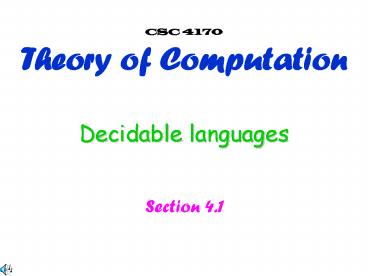Decidable languages - PowerPoint PPT Presentation
Title:
Decidable languages
Description:
Theorem 4.3: AREX is a decidable language. ... Other decidable problems from the language theory. 4.1.f ... Theorem 4.9: Every context-free language is decidable. ... – PowerPoint PPT presentation
Number of Views:299
Avg rating:3.0/5.0
Title: Decidable languages
1
Decidable languages
CSC 4170 Theory of Computation
Section 4.1
2
Examples of decidable languages
4.1.a
- Decidable
- 1,3,5
- ?
- x x is even
- x x is a perfect square
- x x2-10x 0
- x xyz for some integers y,zgt1 (i.e. x is not
prime) - x x is a prime (i.e. x is not divisible by
anything except 1 and - itself)
- ltGgt G is a connected graph
- ltPgt P is a one-variable polynomial expression
with an integral root
- Undecidable
- ltPgt P is a two-variable polynomial expression
with an integral root
3
The acceptance problem for DFAs is decidable
4.1.b
Let ADFA ltB,wgt B is a DFA that accepts
input string w
Theorem 4.1 ADFA is a decidable language.
Proof idea Here is a Turing machine M that
decides ADFA M On input ltB,wgt, where B is a
DFA and w is a string 1. Simulate B
on input w. 2. If the simulation ends
in an accept state, accept. If the
simulation ends in a nonaccept state, reject.
4
The acceptance problem for NFAs is decidable
4.1.c
Let ANFA ltB,wgt B is an NFA that accepts
input string w
Theorem 4.2 ANFA is a decidable language.
Proof idea Here is a Turing machine N that
decides ANFA N On input ltB,wgt, where B is an
NFA and w is a string 1. Convert NFA B
to an equivalent DFA C using the procedure
for this conversion that we learned.
2. Run TM M from Theorem 4.1 on input ltC,wgt.
3. If M accepts, accept. If
M rejects, reject.
5
The string generation problem for REs is decidable
4.1.d
Let AREX ltR,wgt R is a regular expression
that generates string w
Theorem 4.3 AREX is a decidable language.
Proof idea Here is a Turing machine P that
decides AREX P On input ltR,wgt, where R is a
regular expression and w is a string 1.
Convert R to an equivalent NFA B using the
procedure for this conversion that
we learned. 2. Run TM N from Theorem
4.2 on input ltB,wgt. 3. If N accepts,
accept. If N rejects, reject.
6
The emptiness problem for the language of a DFA
is decidable
4.1.e
Let EDFA ltAgt A is a DFA and L(A)?
Theorem 4.4 EDFA is a decidable language.
Proof idea Here is a Turing machine T that
decides EDFA T On input ltAgt, where A is a
DFA 1. Mark the start state of A.
2. Repeat until no new states get marked
3. Mark any state that has a transition
coming into it from any state
that is already marked. 4. If no accept
state is marked, accept otherwise reject.
7
Other decidable problems from the language theory
4.1.f
Each the following languages are also
decidable EQDFA ltA,Bgt A and B are DFAs and
L(A)L(B) ACFG ltG,wgt G is a CFG that
generates string w
Theorem 4.9 Every context-free language is
decidable.
Proof idea Suppose L is a context-free language.
Let G be the CFG that generates L, and S be a TM
that decides ACFG. Here is a Turing
machine H that decides L H On input w
1. Run S on input ltG,wgt. 2. If the
machine accepts, accept if it rejects, reject.































